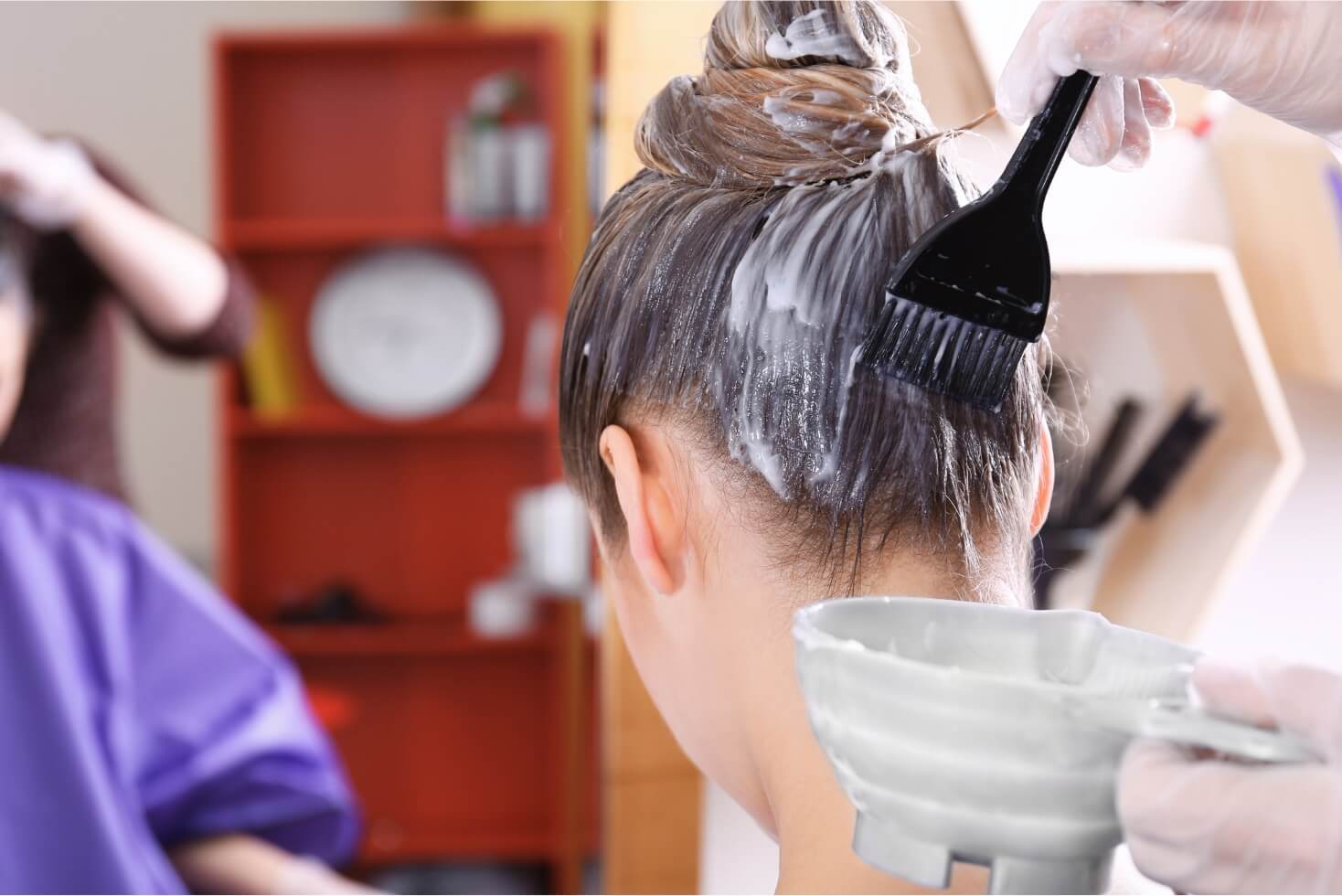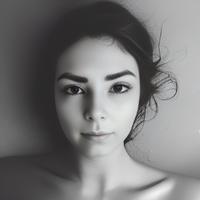Toxic Ingredients in Hair Dyes to Avoid
Updated on
This post may contain affiliate links. As an Amazon Associate, we may earn from qualifying purchases.

The world of beauty products is often filled with hidden dangers lurking beneath glossy labels and eye-catching packaging.
Hair dyes are no exception.
PPD, ammonia, and hydrogen peroxide are just a few of the toxic ingredients found in hair dyes. These toxic chemicals can cause skin irritation, scalp sensitivity, and even paraphylaxis!
To avoid these risks altogether, it’s critical to read the labels carefully and consider potential risks when choosing a product.
In this article, we’ll take a look at some of the toxic ingredients commonly found in hair dyes and why you should avoid them.
Without further ado, here’s the list:
PPD (Para-Phenylenediamine)
Para-Phenylenediamine (PPD) is a chemical compound that is commonly used in hair dyes to create dark, long-lasting colors. It is a derivative of aniline, a colorless organic compound, and is used in many different types of hair dyes, including permanent, semi-permanent, and temporary dyes.
It works by causing a chemical reaction that allows color pigments to cling to the hair shaft. Whilst PPD provides vibrant, long-lasting hair colors, it is also one of the most dangerous ingredients found in hair dyes. It has been linked to skin sensitivities and allergic reactions. At high concentrations or when applied improperly, it can lead to serious health consequences such as contact dermatitis and respiratory problems.
According to a study for Copenhagen University’s Research Centre for Hairdressers and Beauticians, PPD was listed as the prime cause of contact allergy in hair dyes. [1]
How to identify PPD:
- p-Phenylenediamine or paraphenylenediamine
- 4-phenylenediamine
- phenylenediamine
- p-diaminobenzene
- 4-aminoaniline
- 1,4-benzenediamine
- 1,4-diaminobenzene
Ammonia
Ammonia (Ammonium Persulfate) is a white crystalline powder used in hair bleaching products and colorants. It is an alkaline base that helps open the hair shaft’s cuticles so that dye molecules can enter and color the strands.
The dangers associated with ammonia in hair dyes are skin irritation, eye irritation, nausea, and vomiting.
How to identify ammonia:
- Ammonium Hydroxide
- MEA (Monoethanolamine)
- Cocamide MEA
- Aminomethyl propanol (AMEA)
- ETA Ethanolamine
Hydrogen Peroxide
Hydrogen peroxide is a color cream activator. Technically, it’s an oxidizing agent that helps to develop the color by activating ammonia in the hair dye. Because hydrogen peroxide can be caustic, it can cause redness, itching, burning, and blistering on the scalp or other areas of the skin that come into contact with it.
People who are sensitive to this chemical may experience a range of symptoms, including hives, swelling of the face or lips, difficulty breathing, or wheezing when exposed to even a small amount.
How to identify hydrogen peroxide:
- Hydrogen peroxide
- Oxydrol
- Perhydrol
- Superoxol
- Dioxidane
- Oxidanyl
- Perhydroxic acid
- 0-hydroxyol
- Dihydrogen dioxide
- Oxygenated water
- Peroxaan
Resorcinol
Resorcinol is used in hair dyes because of its efficacy in making hair color last longer. It’s usually found in permanent hair dyes used for its strength and ability to bond dyes permanently. Resorcinol, according to a report published by the Scientific Committee on Consumer Safety (Europe), is a strong sensitizer. [2]
How to identify resorcinol:
- Resorcinol
- 1,3-benzenediol
- Resorcin
- 1,3-dihydroxybenzene(m-hydroxybenze, m-dihydroxyphenol)
DMDM Hydantoin
DMDM Hydantoin is a chemical preservative that often goes by the trade name Glydant. On the surface, it seems harmless, but some significant dangers are associated with its use. One of the issues is that it can release Formaldehyde gas.
According to Dr. Trevor Cates, a Neuropathic doctor: “It is most dangerous when inhaled and, in liquid form, can be absorbed through the skin. In addition to being carcinogenic, formaldehyde and its releasers can cause ‘allergic’ reactions, including skin irritations and asthma.” [3]
How to identify DMDM hydantoin:
- 1,2-Dimethylol-5,6-dimethylhydantoine
- Glydant
- 1,3-Bis(hydroxymethyl)-5,5-dimethylimidazolidine-2,4-dione
- 1,3-Bis(hydroxymethyl)-5,5-dimethyl-2,4-imidazolidindion
- 2,4-Imidazolidinedione, 1,3-bis(hydroxymethyl)-5,5-dimethyl
Lead Acetate
Lead acetate is mostly found in progressive hair dyes used for gradual hair coloration, meaning the product has to be applied over time to yield the desired result. For example, covering gray hair.
Lead acetate has been reportedly banned by the FDA in consumer hair dyes due to its high risk of toxicity and potential to cause a variety of neurological problems when inhaled or ingested. Long-term exposure to lead acetate can also increase the risk of skin irritation and allergies, such as rashes, itching, burning, and sensations of redness.
How to identify Lead Acetate:
- Lead Acetate
- Trihydrate
- Lead (II) acetate trihydrate
- Acetic acid lead (II) salt
- Trihydrate
- Lead diacetate
- Trihydrate
- Salt of Saturn
Paraben
Paraben is a preservative used in many cosmetic products to prevent the growth of bacteria, mold, and other biological contaminants. Besides adding more shelf life to cosmetics, they also protect consumers from potential health risks associated with using products that contain pathogenic microorganisms.
While paraben-containing products are designed to be safe for use on the skin and hair, there has been some concern regarding the safety of long-term exposure to this ingredient due to its ability to mimic estrogen in the body.
In vitro studies have demonstrated that certain parabens bind weakly to estrogen receptors in tissue cultures, leading researchers to question whether regular use of paraben-containing hair dye may contribute to an increased risk for certain cancers, such as breast cancer.
Additionally, some research suggests that exposure to paraben could potentially affect reproductive hormones such as testosterone and progesterone, making those exposed to higher levels at greater risk for infertility issues or other reproductive difficulties.
The presence of parabens in hair dye is concerning for many people, given their potential health risks; however, some experts believe the amounts present in most commercial products do not pose a significant threat. Nonetheless, if you are concerned about potential health effects or wish to reduce your exposure, there are alternative options available on the market that exclude parabens from their ingredients list.
How to identify paraben:
- Paraben
- Methylparaben
- Ethylparaben
- Propylparaben
- Butylparaben
- Isopropylparaben
- Isobutylparaben
Benzocaine
Benzocaine is a topical anesthetic or numbing agent that is commonly used as an active ingredient in hair dye products. It works by numbing the scalp, making it less sensitive to the potential irritation that can come with the use of hair dyes. While it has been seen as a helpful tool in reducing discomfort while coloring one’s hair, there are still potential risks associated with using this chemical.
The most significant risk associated with using benzocaine in hair dye is that it can be absorbed through the skin and into the bloodstream, potentially leading to problems like dizziness and headache. Additionally, long-term use of benzocaine could potentially lead to liver damage and even heart arrhythmias. It can also cause allergic reactions such as hives, swelling of the face or throat, difficulty breathing, and itching or burning sensation on the scalp.
Benzocaine has been linked to methemoglobinemia – a decrease in oxygen levels in the blood, which can cause serious health complications if not treated quickly.
It is important for people to consider these risks before deciding to use hairstyling products containing benzocaine in order to ensure their safety and well-being when coloring their hair. Additionally, those with allergies should avoid using any products containing benzocaine altogether since they may increase their risk of an adverse reaction.
Lastly, people should consult a doctor before using any product containing benzocaine if they have any pre-existing medical conditions or are taking medication that could interact with it. This will help ensure they remain safe while styling their hair at home.
How to identify benzocaine:
- Benzocaine
- Ethyl 4-aminobenzoate
- 94-09-7
- Ethyl aminobenzoate
- Ethyl p-aminobenzoate
- Americaine
- Anaesthesin
- Parathesin
- Norcaine
References & Citations
- Søsted H, Rustemeyer T, Gonçalo M, Bruze M, Goossens A, Giménez-Arnau AM, Le Coz CJ, White IR, Diepgen TL, Andersen KE, Agner T, Maibach H, Menné T, Johansen JD. Contact allergy to common ingredients in hair dyes. Contact Dermatitis. 2013 Jul;69(1):32-9. doi: 10.1111/cod.12077. PMID: 23782356.
- SCCS (Scientific Committee on Consumer Safety), Opinion on
Resorcinol (CAS No 108-46-3, EC No 203-585-2), preliminary version of 16 October 2020,
final version of 30-31 March 2021, SCCS/1619/20 - Four harmful ingredients to avoid in your hair products- The Independent UK
About the Author
 Tina Moretti
Tina MorettiTina Moretti, a passionate hair care enthusiast with over a decade of expertise, dedicates herself to empowering women with proven hair care advice. Recognized for her hands-on experience and trusted guidance, Tina turns every strand into a statement of beauty and confidence.